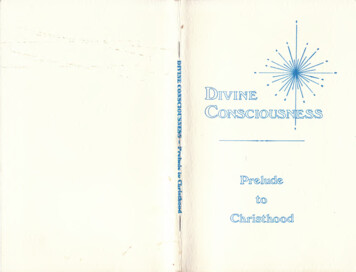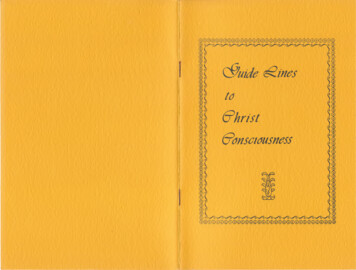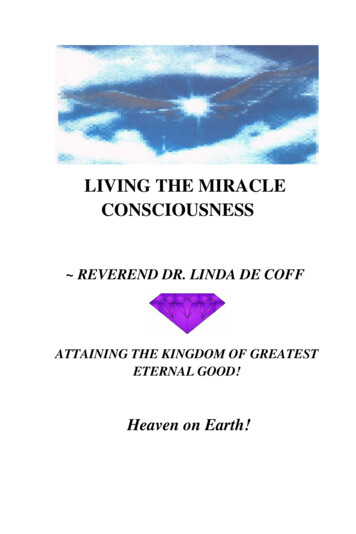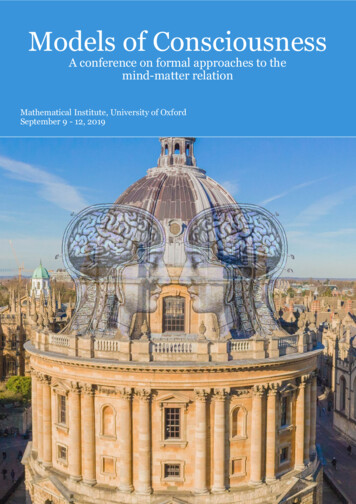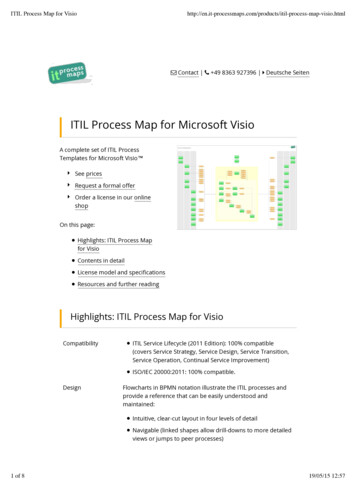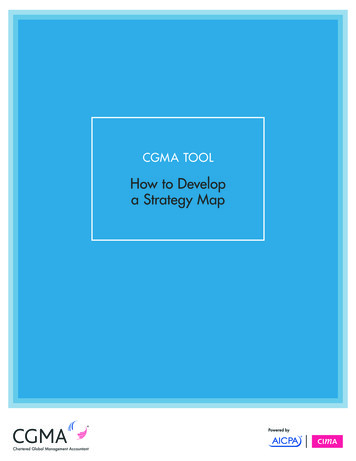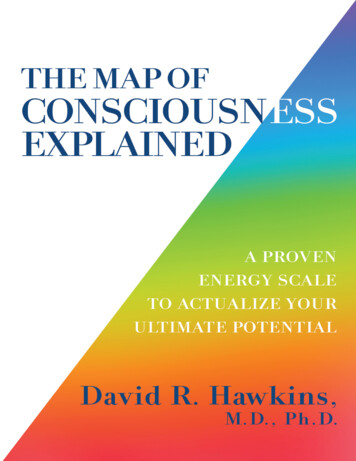
Transcription
Praise for The Map of Consciousness Explained“I recommend this book for every spiritual aspirant for climbingthe unseen ladder of real spiritual progress.”— Swami Chidatmananda, Hindu spiritual monk at Chinmaya Mission, Bharat India
ALSO BY DAVID R. HAWKINS, M.D., PH.D.BooksPower vs. Force: The Hidden Determinants of Human BehaviorThe Eye of the I: From Which Nothing Is HiddenI: Reality and SubjectivityTruth vs. Falsehood: How to Tell the DifferenceTranscending the Levels of Consciousness: The Stairway toEnlightenmentDiscovery of the Presence of God: Devotional NondualityReality, Spirituality and Modern ManHealing and RecoveryAlong the Path to EnlightenmentDissolving the Ego, Realizing the SelfLetting Go: The Pathway of SurrenderSuccess Is for You: Using Heart-Centered Principles for LastingAbundance and FulfillmentBook of Slides: The Complete Collection Presented at the 2002–2011Lectures with ClarificationsOrthomolecular Psychiatry (with Linus Pauling)Dialogues on Consciousness and SpiritualityQualitative and Quantitative Analysis and Calibrations of the Levels ofHuman ConsciousnessAudio Program
The Map of Consciousness Explained (lectures)Please visit:Hay House USA: www.hayhouse.com Hay House Australia: www.hayhouse.com.auHay House UK: www.hayhouse.co.ukHay House India: www.hayhouse.co.in
Copyright 2020 by the David and Susan Hawkins Revocable TrustPublished in the United States by: Hay House, Inc.: www.hayhouse.com Published in Australiaby: Hay House Australia Pty. Ltd.: www.hayhouse.com.au Published in the United Kingdom by:Hay House UK, Ltd.: www.hayhouse.co.uk Published in India by: Hay House Publishers India: www.hayhouse.co.inIndexer: Joan ShapiroCover and Interior design: Julie Davison“Lorenz Butterfly” illustration reprinted by permission of the William Morris Agency, Inc., on behalfof the author 1987 James GleickThe Twelve Steps of Alcoholics Anonymous reprinted by permission of Alcoholics AnonymousAll rights reserved. No part of this book may be reproduced by any mechanical, photographic, orelectronic process, or in the form of a phonographic recording; nor may it be stored in a retrievalsystem, transmitted, or otherwise be copied for public or private use—other than for “fair use” asbrief quotations embodied in articles and reviews—without prior written permission of the publisher.The author of this book does not dispense medical advice or prescribe the use of any technique as aform of treatment for physical, emotional, or medical problems without the advice of a physician,either directly or indirectly. The intent of the author is only to offer information of a general nature tohelp you in your quest for emotional, physical, and spiritual well-being. In the event you use any ofthe information in this book for yourself, the author and the publisher assume no responsibility foryour actions.Cataloging-in-Publication Data is on file at the Library ofCongressTradepaper ISBN: 978-1-4019-5964-7E-book ISBN: 978-1-4019-5965-4
To the memory of Dr. David R. Hawkins(1927–2012)Gloria in Excelsis Deo!
CONTENTSMap of Consciousness Preface by Susan J. HawkinsIntroduction by Fran Grace, Ph.D., editorPart I: FOUNDATIONSCHAPTER 1: Overview of the Map of ConsciousnessUnderstanding Consciousness CalibrationDatabase of ConsciousnessScientific Background of Attractor PatternsThe Columns of the MapQ&ACHAPTER 2: The Levels of ConsciousnessEnergy Level 20: ShameEnergy Level 30: GuiltEnergy Level 50: ApathyEnergy Level 75: GriefEnergy Level 100: FearEnergy Level 125: DesireEnergy Level 150: AngerEnergy Level 175: PrideEnergy Level 200: CourageEnergy Level 250: NeutralityEnergy Level 310: WillingnessEnergy Level 350: AcceptanceEnergy Level 400: Reason
Energy Level 500: LoveEnergy Level 540: JoyEnergy Level 600: PeaceEnergy Levels 700–1,000: EnlightenmentEveryday Examples of How the Levels Determine Human BehaviorQ&ACHAPTER 3: The Evolution of ConsciousnessHaving-Doing-BeingThe Evolution from Survival to LoveConsiderations across 7 Sectors of LifeIntention: Evolving beyond CausalityTruth and the Infinite FieldQ&APart II: PRACTICAL APPLICATIONSCHAPTER 4: Health and HappinessThe Body Obeys the MindOvercoming Negative ProgramsThe Process of Self-HealingThe State of Inner FreedomCHAPTER 5: The “ABC” of Success in 10 StepsStep 1: IntentionStep 2: EnjoymentStep 3: ServiceabilityStep 4: AestheticsStep 5: AttractionStep 6: ReliabilityStep 7: NobilityStep 8: QualityStep 9: SharingStep 10: GraciousnessEveryday Success PracticesAligning Your Compass
CHAPTER 6: The Way Out of AddictionThe Truth about AddictionEnergy Fields and AddictionWhy Give Up an Addiction?Process of Consciousness in RecoveryThe Twelve Steps: Removing the BlocksThe Healing Power of a Loving GroupPart III: ADVANCING CONSCIOUSNESSCHAPTER 7: Transcending the Barriers to Higher ConsciousnessSpiritual WillThe Role of GraceThe Experiencer: Leading Edge of the EgoDualities of the Ego: Attractions and AversionsFrom Shame to PrideFrom Courage to EcstasyThe Pathway of SurrenderCHAPTER 8: Spiritual Truth, Teachers, and Teachings40 Characteristics of Integrous Teachers and TeachingsSpiritual EducationSelf-Realization and Enlightenment of the MysticDivine StatesQ&ACHAPTER 9: Guidance for Spiritual SeekersThe Spiritual DirectionQ&AThe Most Valuable Qualities and Attitudes for the Spiritual SeekerQ&ACONCLUSION: The Essence of the PathReaders’ Guide: Study-Group QuestionsAppendix A: Consciousness CalibrationAppendix B: Calibration Lists for Spiritual Aspirants
GlossaryResources for Further StudyBiographical and Autobiographical NotesEndnotesIndexAbout the Author
Map of Consciousness htenment eace 600BlissIlluminationOneCompleteJoy 540SerenityTransfigurationLovingBenignLove 500ReverenceRevelationWiseMeaningfulReason tance ness 310OptimismIntentionEnablingSatisfactoryNeutrality 250TrustReleasePermittingFeasibleCourage 200AffirmationEmpowermentIndifferentDemandingPride 175ScornInflationVengefulAntagonisticAnger 150HateAggressionDenyingDisappointingDesire 125CravingEnslavementPunitiveFrighteningFear 100AnxietyWithdrawalDisdainfulTragicGrief 75RegretDespondencyCondemningHopelessApathy 50DespairAbdicationVindictiveEvilGuilt 30BlameDestruction
DespisingMiserableShame 20Humiliation The Institute for Spiritual Research, Inc., dba/ Veritas Publishing.This chart cannot be reproduced.Elimination
PREFACEThe first time I saw my husband’s Map of Consciousness, it was on achalkboard in the hallway at home. I asked him, “What’s that?”He said, “Oh, that’s the Map of Consciousness.” He explained to me thathe’d created it to help people understand the world. “Each level ofconsciousness has its own view of life, view of God, view of self, emotion,and process. On a single chart, you see the entire world. It shows a path outof the pits of despair all the way to the state of Enlightenment.”As soon as David explained the Map to me, I saw how it could bringhope to humanity. For decades he had worked as a psychiatrist with allkinds of people who were suffering, even cases of extreme mental illness.He knew the importance in psychiatry of giving someone a tool to inspirethem to come out of their despair. He created the Map as a tool for learningand inspiration.I said, “You’ve got to share this with people!”He told me he wasn’t sure he wanted to go out into the public, so I spokethe words I knew he couldn’t refute: “David, this Map would really helppeople!” After that, he published his first book about the Map, Power vs.Force: The Hidden Determinants of Human Behavior. Little did I know thatwe’d spend the next 20 years traveling the world, sharing the Map ofConsciousness.When I was onstage with him, I witnessed how he would say things in apowerful way and suddenly people’s faces would light up—they got it! Itwas so fulfilling to see that response and to know that someone’s life waschanged. For Dave, it was never about himself—he cared only about themessage and its impact on others. He had a contagious sense of humor; itwas impossible not to laugh whenever he was laughing. He didn’t careabout appearances or getting approval from others, because he knew whoand what he was.
THE BENEFITS OF THE MAP OF CONSCIOUSNESSThe Map that David created has a scale of consciousness from the bottomof human experience to the top. He developed it so we would understandwhy there are both low and high energies in the world, and why somepeople do horrible things while other people are purely loving. The scalegoes from 0 to 1,000, and it’s logarithmic. Dave hired a statistician to makesure the logarithms were correct. Then he put the emotions and otherelements that go along with each level of consciousness so we wouldunderstand what it feels like to be in Shame (20) versus Love (500). Somepeople go for the numbers, others for the words. Dave presented his work indifferent ways to reach people with different learning styles.David wanted to reassure those who are suffering that there’s somethingbetter ahead. As you’ll read later, he himself experienced the whole Map,from the very bottom to the top. He lived by the Map and demonstrated it inhis life, in his lectures, and through his sense of humor. I’ve never metanyone as driven as he was to do anything he could to help others. That’swhy he created the Map. He used it as a tool to inspire people to becomemore loving and compassionate.Nearly every day, I hear from someone who says the Map changed theirlife. Some people have gotten free from the grips of heroin, alcohol, andother hopeless addictions. Others have healed from various illnesses andemotional struggles. Whatever the life problem, the Map gave them apathway out of their suffering.CourageIf this is your first book on this subject, you don’t need to feelintimidated. The Map is a simple, commonsense tool, and you don’t have tobe a genius to understand it. The pages ahead have everything you need toknow to move forward in your life, explaining how the world works, whythings happen as they do, and how you can realize your fullest potential.The Map can explain some of your life’s problems and also remind you ofyour highest calling. Just read and see for yourself how it applies to you.Anyone can use the Map, from any religion or no religion. When I was inhigh school, one of my best friends, who happened to be Jewish, asked me,
“If there’s a God, why do we have all the wars?” The Map tells us why. Itputs the world into perspective. Wars allow millions of people to die forsomething larger than themselves. At the moment that they walk into a hailof bullets, they cross over the critical line of Courage on the Map.Dave said that our biggest problem, spiritually, is the self-centered ego,and it takes courage and dedication to overcome it. That’s the courage wesee in soldiers who risk their lives for something higher than their egos—their country or God or fellows. Athletes do it in their way when they seekto win for their team or their country, instead of wanting fame forthemselves. Or they dedicate their efforts to someone suffering from canceror another illness. When we dedicate what we’re doing to something largerthan ourselves, then we are coming from a higher place. The Map shows usthat terrible things, such as war, actually serve a purpose. They help us toevolve spiritually.HopeWhen people are down, they need hope. The Map gives hope. It shows usthat if we are down in self-hatred or hopelessness, we can turn our livesaround by aiming for a higher level. We see this turning point every day ingroups like Alcoholics Anonymous, with people recovering from addiction.From a place of total despair, their life turns around. When they reach thelevel of Courage (200) on the Map, that’s the point when their lives change,because they’ve found the courage to tell the truth about themselves insteadof blaming someone else. From there, the level of Willingness (310) isimportant. That’s the level of being willing to learn, willing to be helpful toothers, willing to grow, willing to be kind, willing to work at something.There’s always hope, even on the worst days. Some days are so hard, Isay to myself, “I don’t ever want to redo today!” The Map helps us knowthat one bad day isn’t the end of life. As Scarlett O’Hara said in Gone withthe Wind, “I’ll think about it tomorrow!” The Map shows that we are all ona journey. Just because we don’t like the scenery where we are now doesn’tmean the whole journey will look bad; beautiful scenery lies ahead if wehave the willingness to trust the process.Overcoming Difficulties
People say that the Map helps them have compassion for humankind.They see that a lot of the world lives on the lower levels of consciousnesssuch as Guilt, Fear, and Anger, and this means that such people can’t helpbut lie, kill, and steal. Each level has its own reality. If you live on the levelof Fear or Anger, that’s how you act. Just knowing this helps us not to judgethose who act in ways that seem strange to us.Even if you’re at the level of Courage or above, you probably don’t staythere all the time. Something comes up to test you. Everyone goes throughepisodes of the lower levels. For instance, after the death of a loved one,you might have a lot of Grief to process, or Fear of the unknown. In thecase of divorce, you might be angry for a while—until it dawns on you thatyou’re actually better off without that person and situation!As Dave writes in this book: life gives us trials. We are going throughdifficulties for a purpose. When we’re right in the throes of a struggle, it’shard to see the meaning of it, so we have to have faith that there is anoverall purpose to it. David taught me that we can ask, “What’s the purposeof this?” We come to know that we’re not alone in it; there’s a HigherPower looking out for us to help us grow. For example, when we reallywant something but don’t get it, then we may realize later, “I’m so glad Ididn’t get that!”Dave often said, “Love brings up its opposite.” This means that when wecommit to becoming more loving, life will bring us people who are difficultto love! Every action brings forth an equal and opposite reaction. I’m testedevery day by people and situations. Dave taught me that you can’t pleaseeveryone, and that’s a hard lesson to learn. Sometimes it’s necessary to sayno. Sometimes, when someone snaps at you, it’s better to walk away ratherthan stand there and argue with a negative person. If you walk away, thisgives them the chance to feel the impact of their negativity. It can be ateaching moment if they are willing. In all life’s moments, learning occurs.Sometimes we’re the teacher, and sometimes we’re the student.EMBRACE WHAT YOU AREA wonderful goal is to live at the level of Love (500), but this isn’t easy.Many people come to me and say, “I’m in the 500s.” They think they live atthe level of Love, but it’s more fantasy than fact. When you read about that
level of Love in this book, you’ll see that there’s almost no one who lives atit! You’d have to be close to a saint. If you’re in the 400s, which is the levelof Reason, high functioning, and seeking the Truth for its own sake, thenyou’re doing well. You might have glimpses of a higher level, but it takesconstant devotion to live there, and no one can take you there. You canexperience it, and then you have to do the inner work to get there and staythere. You can’t force yourself to “achieve” a higher level; that’s ego. It hasto come from willingness, essence, and heart.David says in this book that basic kindness to others plays a major role indaily life and spiritual progress. For instance, if you see an old lady havingtrouble with her grocery cart, let her go in front of you. Maybe she’s tired ofstanding. Be kind to the pregnant mom with a screaming kid in her cart.Instead of giving her a dirty look and judging her as a “bad mother,” let hergo in front of you. What’s 10 more minutes? If your goal is to evolve, thenkindness is a vital tool.Another point that Dave emphasizes is that one level is not better thananother, because each level has its own responsibility. Just try to be as gooda person as you can be, and to live in that space for as long as you can.When you reach the level of Acceptance (350), then you have embracedwho and what you are. We all come in at different levels, and it takes totalcommitment to evolve to a higher level. Wearing white robes and saying theright words doesn’t mean you’re on a higher level; it means your ego thinksyou are!If you have the capacity to be honest and not judge anything as “high” or“low,” then you’ll have a good self-understanding, an inner sense of whereyou are on the Map. If you want to evolve, just look at where you canimprove yourself. Be honest about your weaknesses. Maybe you areimpatient and need to be kinder. Maybe you’re attached or addicted tosomething and need to have the courage to surrender it. Maybe you’re adoormat and need to stop letting people walk all over you. I like the saying“First time, shame on you; second time, shame on me!” Just becausesomeone is a family member or colleague doesn’t mean you allow them tomistreat you.Sometimes people think they will evolve by immersing themselves in thehighest energy fields. They tell me, “I’m only going to listen to music andread books that are at the very top of the Map!” They judge everything in
the world as “lower.” This is the spiritual ego’s holier-than-thou attitude. Ifthey were at the level they think they are, they would see their error.The ego likes to be special. The ego says, “I’m here, and you’re there.”That’s not what the Map is for. It’s a tool for you to learn and grow. Ifyou’re honest about what you struggle with, you’ll see how to overcome itand automatically move up the Map.Dave never once said, “I am an enlightened teacher,” yet I saw him liveat that level. He was very humble and down-to-earth. He didn’t see himselfas any better than anyone else. He just knew he had a responsibility to sharewhat he was and help the world any way he could. When you are it, youdon’t have to say anything about yourself. At the higher levels, you have nointerest in promoting yourself. I saw Dave meet with people who needed hishelp as a doctor, and all they gave him in return was a sack of coffee. Afterhe passed away, it took me two years to do something with all of thatcoffee!This book is dedicated to his memory, because his life gives us awonderful example of selfless service for the betterment of humankind. Ihope and pray you find this book helpful for your journey. As Dave told us:“Straight and narrow is the path. Waste no time!”—Susan J. Hawkins,President of the Institute of Spiritual Research,founded by Dr. David R. Hawkins
INTRODUCTIONA few months before he passed away, I was sitting with Dr. Hawkins athis home and pointed to the long shelf of books he had written. “What’s itlike to know you wrote all those books?” He said, “I don’t see the books asmine. It wasn’t the personal self that wrote the books. God was lookingaround for a mind that wasn’t thinking. I was just a channel, a space thatwas empty. People see a body and a person, and they think that the personwrote the books. But that wasn’t the case. It was like a violin—it can’t playitself; it has to be played.” Long silence. And then he said, chuckling, “Istopped thinking years ago. I don’t need to think. It’s like a saw . . . toomuch noise!”1Dr. David R. Hawkins (“Doc”) was a rare combination of genius andhumility. His life was unusual. I mean, who can imagine a mind empty ofall thoughts? “Misfit,” he liked to say, with a hearty laugh. It was a play onwords. We were talking about mystics, and he said, “Yes, that’s what peoplecall me—one of those ‘misfits’!”2The details of his personal life were not important to him after certainspiritual experiences extinguished his personal self. “The Presence itself isall that’s here in this moment” is how he began his daylong lecture at theInstitute of Noetic Sciences in 2003. Indeed, he rarely used personalpronouns, a style that makes his writings unusual in modern times but isvery similar to the expression of historical mystics. Since today’s readerslike to know who an author is and what led to the unique discoveries in abook such as this, the following is a brief narrative introduction to theauthor and his trademark Map of Consciousness .ABOUT DR. HAWKINS
Dr. Hawkins was born in 1927 in Wisconsin and grew up during theGreat Depression. Religiously, his family was Episcopalian, and he servedas an altar boy and sang in the boys’ choir. However, his profound spiritualexperiences occurred outside of any religious context.At age three, sitting in a little wagon, he had a stunning awareness ofexistence. Reflecting on that moment from childhood, he told a group of us:“It was as if there had been total darkness, oblivion, and then suddenly giantcleave lights came on. I saw I was back in a body and I was not happy!” Heexplained that in previous lifetimes he had been a devout HinayanaBuddhist and followed a pathway of negation to the Void (“Nothingness”),believing it to be the ultimate spiritual goal. But it was not, or else hewouldn’t have ended up back here in a body! Instantly, with the realizationof existence, there was the fear of nonexistence. It was a preverbalconfrontation with the paradox of Nothingness versus Allness, a highlyadvanced spiritual gateway (“conundrum” was another word he used todescribe the confrontation with seeming opposites) that he did not resolveuntil decades later, and his teaching on the Void is one of his most importantcontributions to spiritual aspirants. (See Chapter 8.)“With that kind of a childhood, this was a strange life to begin with!” Heoften chuckled at the oddities of his life. “Frankly, other children seemedextremely boring, and so I escaped into Plato and Socrates. While otherboys were playing stickball, I was reading Aristotle and listening to theweekly opera program!”3He was also very industrious. By age 12, he had the longest newspaperroute (17 miles) in the region; with no electricity along the highway,everything was pitch black. One time a winter storm hit, and gustingsubzero winds toppled over his bicycle, scattering all the newspapers. As hedescribes in Chapter 8, he punched his way into a crusted snowbank on theside of the road to get out of the freezing wind. No sooner had he burrowedinto the snowbank than he melted into the Infinite Presence of Love. Theexperience was so unforgettable that 70 years later, when I asked him todescribe that state of Infinite Love, he didn’t miss a beat: “All negativeemotion—fear, impatience, frustration—disappeared. Instead there wasonly the Radiance of Infinite, timeless, everlasting, all-encompassing Love,which was not different than the Reality of what I was, what I am.”4Compared to this Infinite Love, the “God” of religion now seemedirrelevant to the young David. At age 16, his belief in religion disappeared
altogether. One day, while walking in the woods, an awareness of humansuffering throughout the ages suddenly overwhelmed him, like a massivedark cloud. In that moment, he blamed God for all the suffering in the worldand became an atheist.Yet, despite the collapse of religious belief in God, he had a relentlessinner drive to get to the truth of existence: “There was an inner core withinconsciousness that was desperate to reach some greater truth.”5 Born withan exceptionally high IQ, he easily mastered the world of science, theology,medicine, and psychiatry, through the intellect. After service on aminesweeper in the U.S. Navy during World War II, he completed medicalschool while holding three jobs and soon became the head psychiatrist,running a large hospital in New York and publishing a plethora of scientificarticles based on his clinical research. He went through many years ofpsychoanalysis with one of the leading Freudians at that time. He was adedicated Zen Buddhist meditator, sitting for an hour in the morning and anhour in the evening. Yet all of these investigations only brought deeperdespair. Though he had reached the pinnacle of worldly success, he wasconfronted with a vast and way-less inner darkness.The crisis culminated in 1965 when he was 38 and at the point of deathdue to a progressive and fatal illness. All his efforts to pursue the truth ofexistence via the intellect had failed, and he found himself in a state ofextreme anguish and despair. Just before he was about to die, the thoughtflashed through his mind, What if there is a God? And with that, he calledout a prayer—“If there is a God, I ask Him to help me now”—and hesurrendered totally to “whatever God there might be,” not expecting much.Immediately he went into “oblivion.” It took him 30 years to recount theearth-shattering aftermath: “[T]he oblivion suddenly disappeared and wasreplaced by the stunning splendor of the Light of Divinity that shone forthas the radiance and essence of Allness.”6His consciousness had been completely and suddenly transfigured. Themind and its mental patterns were gone forever, replaced by the Presence,“an infinite, all-encompassing awareness which is radiant, complete, total,silent and still.”7 A peaceful inner silence prevailed, as there were noimages, concepts, or thoughts. In fact, there was no “person” left to think;all separateness between him and others dissolved, and he saw the samebeautiful, timeless perfection in everyone around him: “A radiance shines
forth from everyone’s face; everyone is equally beautiful.”8 In this state ofnonduality, each living thing “is aware of every other, and all things areinterconnected and in communication and harmony by means of awarenessand by sharing the basic quality of the essence of existence itself.”9 Nothingis better or worse, higher or lower than anything else. “All sentient beingsare equal . . . All things are intrinsically holy in the divinity of theircreation.”10Dr. Hawkins, in Power vs. Force, says that the work on the Map ofConsciousness “began in 1965,” by which he means this transfiguration ofhis own consciousness. He may well be the first person trained as a clinicalscientist/physician to undergo the transformation classically termed“Enlightenment,” or unio mystica—and then been able to contextualize thecondition in lectures and books. While many of us have transient momentsof “flow,” intense joy, or self-transcendence at certain peak experiences (thebirth of a child, athletic feats, stage performance, creative work, mountainclimbing, or lovemaking, to name a few) or even life-altering spiritualtransformations (near-death experiences, for example, or beatific visions), itis exceedingly rare for a person’s consciousness to be transfigured suddenlyand permanently into a nondual state. Historically, most such people eitherleave the body (death) or remain in “God-shock,” unable to speak about thestate of ego dissolution, when all sense of a personal self dissolves—likesugar melting into warm water. As William James tells us in his classic TheVarieties of Religious Experience, the mystic experience is “ineffable”—impossible to describe.11In the wake of this transfiguration of consciousness, Dr. Hawkins’s lifewas never the same, and it took years to adjust to the changes. The nervoussystem felt strained, like “high-tension wires burning with high-voltageenergy.” In social interactions, he felt bewildered when people referred tohis body as “David,” because he knew himself to be everywhere and onewith everything: “Somebody would ask me a question and I would wonderwho they were talking to!” When he looked into the eyes of others, he sawonly “the one Self. . . . There isn’t any separate you, there, and me, here.”12The blissfulness and self-completion made it difficult to summon interest innormal functioning. The old motivations of income and success wereirrelevant. The only motivation strong enough to pull him back into the
body and the world of form, he said, was love: “Love becomes the solemotivator of the continuance of physical existence.”Each time it is extremely difficult to come back into the body. . . . Youfeel homesick . . . like one has left one’s home for some kind of a taskone has agreed to. Whenever I go into that state, there is no form. Onejust dissolves into infinite, golden love. It is so exquisite that it makesone cry to have to come back into the body again. The only reasonyou can leave it is because you know it is there forever, and that youwill return forever.13One time, he told me, he was alone in the woods and a bliss state tookover. He was aware that vultures were circling his body, poised to descendas soon as the last breath left his body. But he realized he might as well stayin the body if it helped others, because the bliss was forever and always. Hesurrendered the body completely to be an instrument of service in theworld, allowing it to be reenergized. As soon as this happened, the vulturesflew away.He gradually acclimated to the new state of consciousness and returnedto his psychiatric practice, which became the largest in the United States.His expanded spiritual state led him to see beyond the limits ofconventional treatments to the inner humanness of his patients. He wasunstoppable in trying every avenue of treatment for his patients, no matterwhat his more conventional peers had to say about it. Because of thedramatic healing of hopeless patients, Dr. Hawkins appeared on majornetwork television shows during the 1970s and ’80s. His pioneering workin many areas of human suffering resulted in numerous national andinternational recognitions, listed in the About the Author section at the backof the book.Despite these successes, his “one patient at a time” efforts as a doctorse
Transcending the Levels of Consciousness: The Stairway to Enlightenment Discovery of the Presence of God: Devotional Nonduality Reality, Spirituality and Modern Man Healing and Recovery Along the Path to Enlightenment Dissolving the Ego, Realizing the Self Letting Go: The Pathway of Surrende

